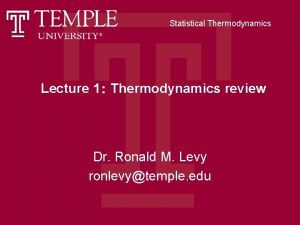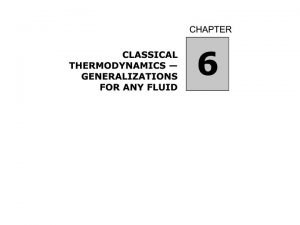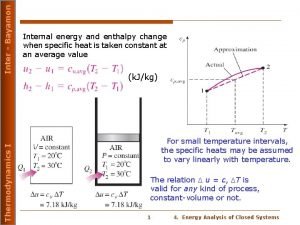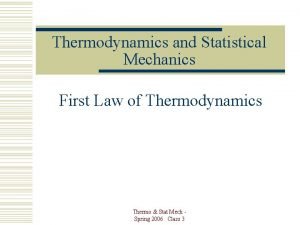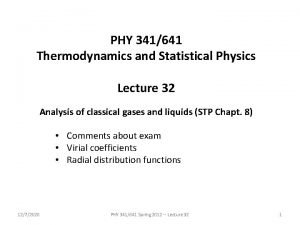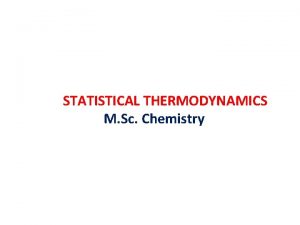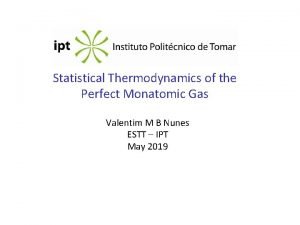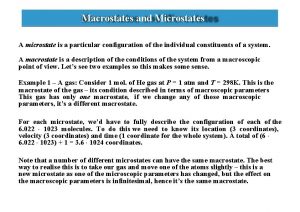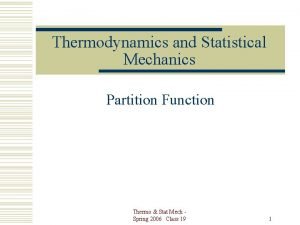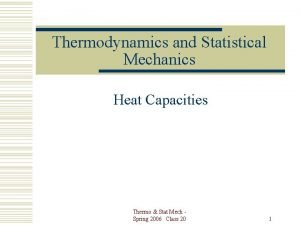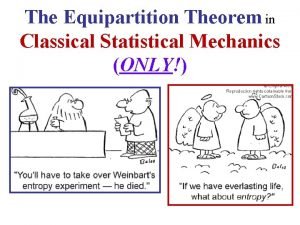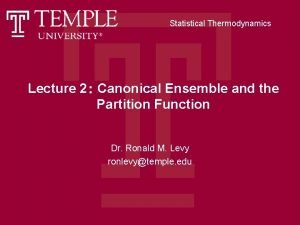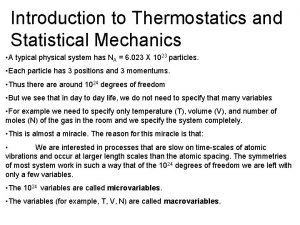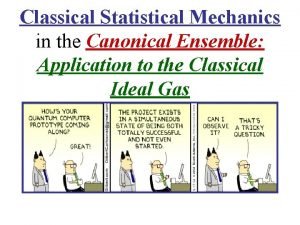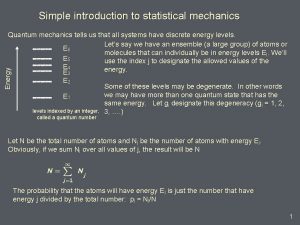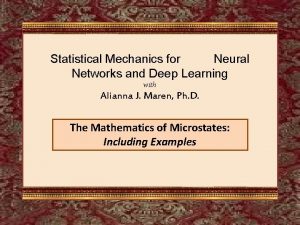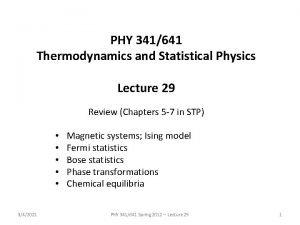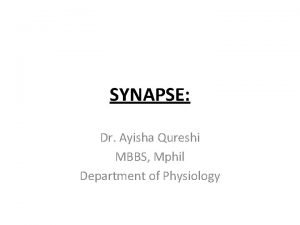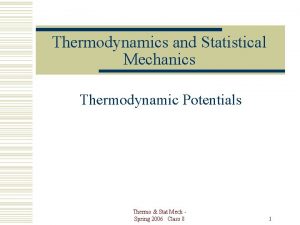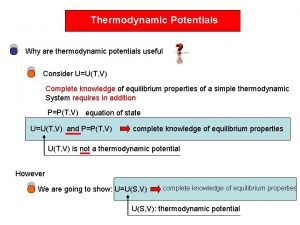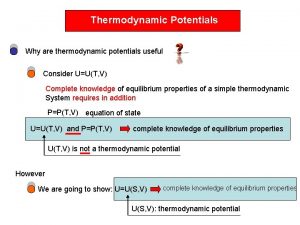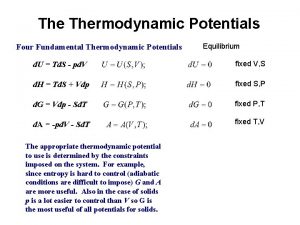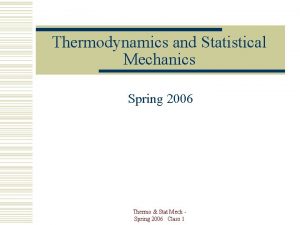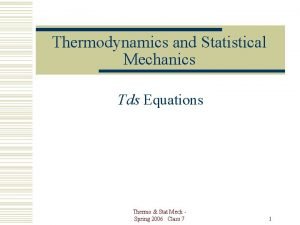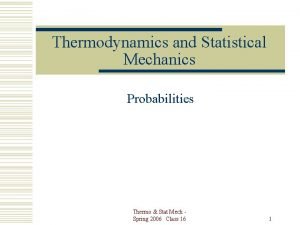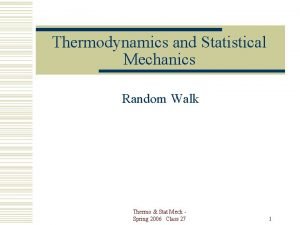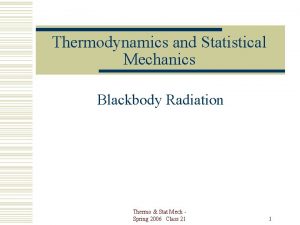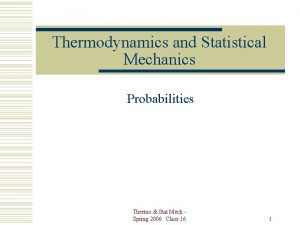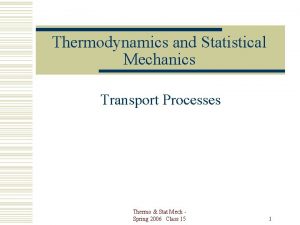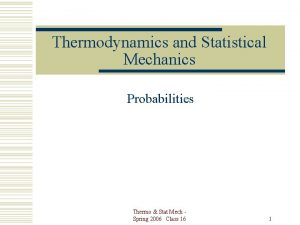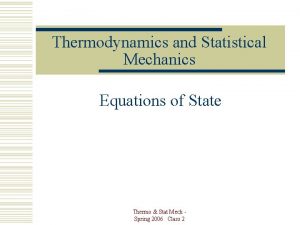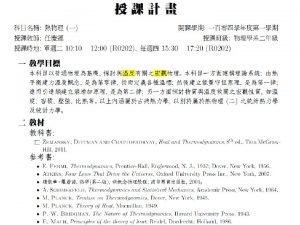Thermodynamics and Statistical Mechanics Thermodynamic Potentials Thermo Stat



















- Slides: 19

Thermodynamics and Statistical Mechanics Thermodynamic Potentials Thermo & Stat Mech Spring 2006 Class 8 1

Thermodynamic Potentials There are two energy functions that have been used so far: Internal Energy Enthalpy There are two more. Thermo & Stat Mech - Spring 2006 Class 8 2

Properties From first law: Td. S = d. U + Pd. V, or Internal Energy d. U = Td. S – Pd. V U(S, V) Enthalpy: H = U + PV d. H = Td. S + Vd. P Thermo & Stat Mech - Spring 2006 Class 8 H(S, P) 3

New Potentials Helmholtz Function: F = U – TS Gibbs Function: G = U – TS + PV G = H – TS G = F + PV Thermo & Stat Mech - Spring 2006 Class 8 4

Properties Helmholtz Function: F = U – TS d. F = d. U – Td. S – Sd. T First Law: d. U = Td. S – Pd. V d. F = – Pd. V – Sd. T Thermo & Stat Mech - Spring 2006 Class 8 F(V, T) 5

Properties Gibbs Function: G = U – TS + PV d. G = d. U – Td. S – Sd. T + Pd. V + Vd. P First Law: d. U = Td. S – Pd. V d. G = – Sd. T + Vd. P Thermo & Stat Mech - Spring 2006 Class 8 G(T, P) 6

Internal Energy d. U = Td. S – Pd. V Thermo & Stat Mech - Spring 2006 Class 8 U(S, V) 7

Enthalpy d. H = Td. S + Vd. P Thermo & Stat Mech - Spring 2006 Class 8 H(S, P) 8

Helmholtz Function d. F = – Pd. V – Sd. T Thermo & Stat Mech - Spring 2006 Class 8 F(V, T) 9

Gibbs Function d. G = – Sd. T + Vd. P Thermo & Stat Mech - Spring 2006 Class 8 G(T, P) 10

All Four d. U = Td. S – Pd. V d. H = Td. S + Vd. P d. F = – Pd. V – Sd. T d. G = – Sd. T + Vd. P Thermo & Stat Mech - Spring 2006 Class 8 U(S, V) H(S, P) F(V, T) G(T, P) 11

Maxwell Relations Thermo & Stat Mech - Spring 2006 Class 8 12

Legendre Transformation If Y is a function of x, i. e. Y = Y(x), the Legendre transformation provides a means to create a new function Y, which is a function of D, where, The independent variable is changed from x to Thermo & Stat Mech - Spring 2006 Class 8 13

Legendre Transformation Thermo & Stat Mech - Spring 2006 Class 8 14

Legendre Transformation The equation of the tangent line is, Y = Dx + Y, where, Then, Y = Y – Dx, and Thermo & Stat Mech - Spring 2006 Class 8 15

Legendre Transformation To change more than one variable, Y = Y – D 1 x 1 – D 2 x 2, etc. Thermo & Stat Mech - Spring 2006 Class 8 16

Legendre Transformation Examples: U(S, V) Change from S to T. F = U – TS Thermo & Stat Mech - Spring 2006 Class 8 17

Tds Equations Thermo & Stat Mech - Spring 2006 Class 8 18

Joule-Thomson coefficient h = u+Pv dh = đq + vdp = Tds + vdp = 0 Tds = – vd. P Thermo & Stat Mech - Spring 2006 Class 8 19
 Thermodynamic potentials
Thermodynamic potentials Maxwell relations
Maxwell relations Thermodynamic square
Thermodynamic square What is cv in thermodynamics
What is cv in thermodynamics Thermodynamics and statistical mechanics
Thermodynamics and statistical mechanics Thermodynamics and statistical mechanics
Thermodynamics and statistical mechanics Statistical thermodynamics is a study of
Statistical thermodynamics is a study of Statistical thermodynamics
Statistical thermodynamics Microstate and macrostate examples
Microstate and macrostate examples Partition function in statistical mechanics
Partition function in statistical mechanics Statistical mechanics
Statistical mechanics Classical equipartition
Classical equipartition What is microcanonical ensemble
What is microcanonical ensemble Relation between partition function and internal energy
Relation between partition function and internal energy Partition function in statistical mechanics
Partition function in statistical mechanics Introduction to quantum statistical mechanics
Introduction to quantum statistical mechanics Statistical mechanics of deep learning
Statistical mechanics of deep learning Statistical mechanics
Statistical mechanics Epsp vs ipsp
Epsp vs ipsp Source of bioelectric potential isin nature.
Source of bioelectric potential isin nature.

